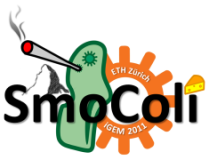Team:ETH Zurich/Biology
From 2011.igem.org
| Line 9: | Line 9: | ||
|} | |} | ||
|- | |- | ||
| - | |colspan="2"|'''A brief overview of | + | |colspan="2"|'''A brief overview of our system can be found here.''' |
|} | |} | ||
Revision as of 01:37, 22 September 2011
| Biology |
| ||
| A brief overview of our system can be found here. | |||
General ideaSmoColi is a bacterial system which is able to sense and quantify smoke in the air. The quantification of smoke works in the same way as a thermometer: A band of GFP gets shifted along an axis depending on the concentration of smoke sensed by the bacteria. If the amount of smoke gets to high, an alarm system is switched on and thus warns people when the smoke could cause health damage. Experiments are performed in Escherichia coli strains JM101 and DH5α. SmoColi can be used in channels and tubes of different sizes depending on the application field. Because of the simple setup of the system it is a convenient mean to define concentrations of sensor molecules from air probes. It could be used for example as a rapid test to quantify specific molecules in probes. |
Network elementsThe SmoColi circuit design can be devided into three different subsystems: 1. a sensor 2. bandpass filter 3. alarm system Both a repressor (coupled to an inverter) or an activator can be used as sensor parts of the system. In our case we used AlcR (from aspergillus nidulans), respectively XylR (from pseudomonas putida) regulatory proteins in order to sense compounds present in smoke and thereby to induce the different parts of our network. Upon sensing the specific molecule the bandpass filter gets activated and results in a green band of GFP. The higher the concentration of the inducer molecule, the longer the distance which the band moves along the tube. The sensor device is also coupled to an AHL-dependent alarm system. If the inducer molecule exceeds a certain threshold value, no more AHL will be produced and the cells turn red. For a detailed description of the circuit design please click here. You can see details about how we designed our plasmids on the following page and details about the protocols we used here. |
 "
"



